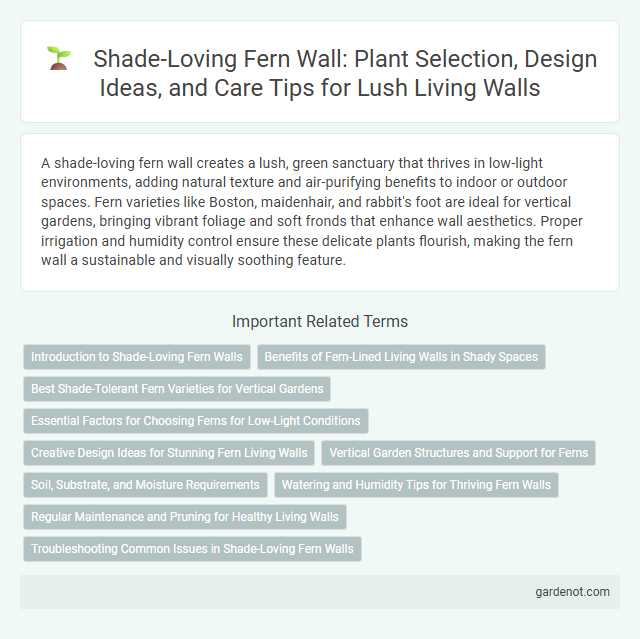A shade-loving fern wall creates a lush, green sanctuary that thrives in low-light environments, adding natural texture and air-purifying benefits to indoor or outdoor spaces. Fern varieties like Boston, maidenhair, and rabbit's foot are ideal for vertical gardens, bringing vibrant foliage and soft fronds that enhance wall aesthetics. Proper irrigation and humidity control ensure these delicate plants flourish, making the fern wall a sustainable and visually soothing feature.
Introduction to Shade-Loving Fern Walls
Shade-loving fern walls create lush, vibrant vertical gardens by featuring ferns that thrive in low-light environments, making them ideal for shaded indoor or outdoor spaces. Species such as Boston fern (Nephrolepis exaltata) and maidenhair fern (Adiantum) offer dense foliage and air-purifying benefits. These living walls enhance aesthetic appeal and improve indoor air quality while requiring minimal maintenance and indirect sunlight.
Benefits of Fern-Lined Living Walls in Shady Spaces
Shade-loving fern walls enhance living spaces by improving air quality through effective pollution filtration and humidity regulation. Fern-lined living walls provide natural insulation and noise reduction, creating a healthier, more tranquil environment in shaded areas. Their lush, green foliage supports biodiversity, attracting beneficial insects while requiring low maintenance and thriving without direct sunlight.
Best Shade-Tolerant Fern Varieties for Vertical Gardens
Shade-loving fern walls thrive with varieties such as Boston fern (Nephrolepis exaltata), Maidenhair fern (Adiantum), and Japanese painted fern (Athyrium niponicum), which excel in low-light vertical garden conditions. These ferns offer lush foliage and resilience, making them ideal for creating vibrant, green walls in shaded environments. Selecting moisture-retentive substrates and ensuring proper humidity further enhance fern health and vertical garden longevity.
Essential Factors for Choosing Ferns for Low-Light Conditions
Shade-loving fern walls thrive when selecting ferns such as Boston fern, maidenhair fern, and bird's nest fern, known for their adaptability to low-light environments. Essential factors include ensuring high humidity, well-draining soil, and consistent moisture to prevent drying out and promote lush growth. Optimal placement away from direct sunlight and regular misting help maintain the delicate fronds and vibrant greenery characteristic of successful fern living walls.
Creative Design Ideas for Stunning Fern Living Walls
Shade-loving fern walls create dynamic green installations by combining diverse fern species with varying leaf textures and shades of green to enhance visual depth. Incorporating materials like reclaimed wood or natural stone as backing supports the lush foliage while adding an organic architectural element. Strategic layering and asymmetrical patterns maximize light capture in shaded areas, promoting healthy growth and a stunning, immersive living wall display.
Vertical Garden Structures and Support for Ferns
Shade-loving fern walls thrive on vertical garden structures designed with moisture-retentive materials and durable support frameworks, ensuring optimal hydration and airflow. Specialized mounting systems like modular panels or wire grids provide stability while accommodating fern root zones. These structures enhance vertical gardening by promoting healthy growth and maximizing space efficiency in shaded environments.
Soil, Substrate, and Moisture Requirements
Shade-loving fern walls thrive in well-draining, nutrient-rich soil composed of organic materials like peat moss, compost, and loam to retain moisture without waterlogging roots. The substrate should provide excellent aeration and consistent moisture retention, with a pH level ranging from 5.5 to 7.0 to support optimal fern growth. Maintaining high humidity and regularly moist conditions is essential to prevent drying out, while avoiding stagnant water to protect against root rot.
Watering and Humidity Tips for Thriving Fern Walls
Shade-loving fern walls thrive in consistently moist soil with regular watering schedules that prevent drying out but avoid waterlogging. Maintaining high humidity levels between 50-70% promotes lush, healthy fronds and reduces brown tips or wilting. Using misting techniques or humidifiers around the fern wall helps replicate their native damp environments for optimal growth.
Regular Maintenance and Pruning for Healthy Living Walls
Regular maintenance of shade-loving fern walls includes consistent watering to keep the soil moist and prevent fungal growth. Pruning involves removing dead or yellowing fronds to encourage new growth and improve air circulation, which reduces the risk of pests and diseases. Monitoring humidity levels and providing indirect light conditions ensure the ferns thrive in optimal environments for healthy living walls.
Troubleshooting Common Issues in Shade-Loving Fern Walls
Shade-loving fern walls often face challenges such as yellowing fronds caused by overwatering or poor drainage, which can be resolved by adjusting watering frequency and improving soil aeration. Pests like spider mites and aphids may infest these green walls, requiring regular inspection and application of insecticidal soap for effective control. Insufficient humidity can lead to browning leaf tips, so maintaining humidity levels above 50% with misting or humidifiers supports fern health and vibrancy.
Shade-loving fern wall Infographic

 gardenot.com
gardenot.com